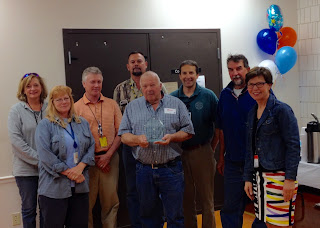The Iron Range Meter Service team, located in northeast Wisconsin and northern Michigan, reached two venerable milestones in the past week: 52 years without a lost-time injury as of June 1, and an even 19,000 days without a lost-time injury as of June 8.
In other words, the last time they experienced a lost-time injury, humans hadn’t even landed on the moon.
Of course, a lot has changed during that time.
“Conditions years ago were different,” says Rick Lapp, meter reader (north), who has been with We Energies for 32 years. “There were a couple winters where we were on snow shoes from Dec. 1 all the way to May. We don’t do that much anymore. Same with dogs. It seems I used to pet a dog every other minute; now, it’s hardly ever.”
 |
Working in northeast Wisconsin
and northern Michigan means
safely accessing meters even in extreme weather conditions. |
“The manner in which we do our jobs has changed,” adds Jeanette Larison, meter reader (north), who has been with the company for 14 years. “A lot of rushing has been taken out. We can pay attention to risk quite a bit more, further reducing the potential for injury.”
Much of that is due to the drive-by system instituted during the past decade, allowing the meter readers to drive by locations and read the meters from their vehicles, instead of walking up to every meter to read them manually. But that still leaves a lot of driving time – as much as 300 miles a day, in addition to commuting to and from home – with potential hazards ranging from road conditions to wildlife such as deer, wolves, bears and moose.
“They’re like a 20-pound sandbag coming through your windshield,” is how Tony Westerberg, meter testing leader (north), describes the danger even wild turkeys pose.
“Not structured communication, but caring communication”
What hasn’t changed throughout each of the 19,000 days is the level of communication that takes place among the team.
“We communicate to each other things we find in the field that could be a hazard,” Larison says.
They talk about them in safety meetings and, perhaps more important, they make safety topics part of their routine conversations with coworkers, with the linemen and gas fitters they come into contact with, and even with employees from other utilities.
 |
| Meter staff in 2015 accepting 50th year without lost-time injury award. |
“Having a good bunch of people to work with and that you can talk to really helps, and this always has been a good group to work with,” Lapp says.
Westerberg, who has been with We Energies for 26 years, also credits the company’s program for tracking actions or situations that could have resulted in injury, death or property damage, but for some reason didn’t – this time. “It documents working conditions for us to be aware of so that we’re safety-conscious in all directions,” he explains.
He agrees with Larison and Lapp that it’s the daily conversations that help keep each other safe, as well as the notations they make in their records. He gave the example of the record for one residence that noted, “Beware of raccoons.” During the next meter reading, which still needed to be done manually, the reader saw the notation and knew to look around the property’s out buildings, where he found the area where the raccoons seemed to frequent. He made sure not to aggravate them.
“We communicate all those subtle things, and that plays a critical part in our ongoing safety. It’s not a structured communication, but a caring communication,” Westerberg says, adding that going home healthy and with all parts intact – and making sure your coworkers can do the same – is what it’s all about.
Taking safety home
It’s not just going home that’s important, but being safe there, too. Westerberg describes that his attire when cutting grass in the summer consists of shorts and a tank top, as well as safety glasses and boots. “My neighbors may think I look odd, but it’s safety first,” he says.
Lapp also lives the safety mentality at home, teaching it to his children. His daughter works in landscaping, where cutting and moving 50-pound pavers is part of her day. “I told her to get safety-toed shoes, and to wear a mask and safety glasses when cutting the pavers,” he says. “Because you’re aware of safety issues, you try to make your kids aware of them, and that comes from working here.”
His safety tip? “As I tell my kids, just pay attention, period – whether it’s to the other driver or to conditions.”
Westerberg agrees, pointing to the importance of “aim-high driving.”
“Be aware of what is off in the distance. Look way up, beyond the car ahead of the car in front of you. If you see a deer crossing, chances are there is more than one. Watch your mirrors, too, for what’s coming up behind you. Some things are uncontrollable, but other things like aim-high driving help save potential situations from happening.
“Some people may say, ‘Yeah, but what didn’t get reported?’” Westerberg adds. “Believe what you like, but we’ve gone home safely every day so far. We’re proud of it, but just happy to go home safe.”
Lapp agrees. “Setting a record is good, but going through each day without a lost-time injury is how it should be.”













